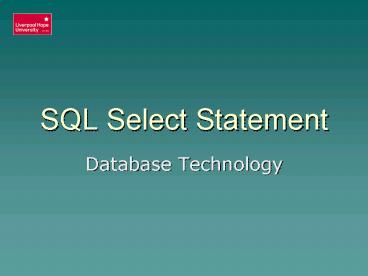SQL Select Statement PowerPoint PPT Presentation
1 / 26
Title: SQL Select Statement
1
SQL Select Statement
- Database Technology
2
Aims
- To introduce
- SELECT statement
- FROM clause
- WHERE clause
- AND and OR conditional statements
- Relational Operators
3
Aims
- To Demonstrate
- Retrieving attributes from more than one table
- Hiding duplicate values in the result of a query.
4
SQL SELECT Statement
- SQL SELECT statement allows to ask questions of
our stored data. - SELECT from
- Tables in our database
- Within the tables
- Particular records (rows)
- Particular attributes (columns)
5
Tables in our database
Imagine we wish to display all the attributes and
all the rows in the supplier table
6
Simplest SELECT statement
- SELECT allFields
- FROM singleTable
- SELECT
- FROM tblSupplier
7
Simplest SELECT statement result
All attributes and all records in the supplier
table
8
Projection using a SELECT statement
- Projection is where we select only particular
attributes (columns) in our table. - SELECT attribute1, attribute2
- FROM tableName
9
Result of Projection
SELECT supplierID, suppName FROM tblSupplier
10
Selection using a SELECT statement
- To select only particular rows we must add an
additional clause to our select statement. - The WHERE clause.
- contains a condition
- rows are checked against the condition
- only rows which match the condition will be
returned in the result.
11
Selection using a SELECT statement
- SELECT attributes
- FROM tableName
- WHERE attributecondition
12
Selection using a SELECT statement
- SELECT supplierID, suppName, suppAdd1, suppAdd2,
suppPostCode - FROM tblSupplier
- WHERE suppName"Mayumi's"
13
Combination using Selection and Projection
- SELECT supplierID, suppName
- FROM tblSupplier
- WHERE suppName"Mayumi's"
14
SQL Relational Operators
- SQL uses the following simple relational
operators. - equals
- lt is less than
- gt is greater than
- lt is less than or equal
- gt is greater than or equal
- ltgt is not equal
15
Records in the products table
16
Selection using a relational operator
- SELECT prodID, prodDesc, cost
- FROM tblProduct
- WHERE cost gt 20
17
AND and OR
- Combining conditions in the WHERE clause.
- Both conditions must be true for a record to be
returned. - Either condition may be true for a record to be
returned
18
AND
- SELECT prodID, prodDesc, cost, category
- FROM tblProduct
- WHERE costgt30
- AND category"Confections"
19
OR
- SELECT prodID, prodDesc, cost, category
- FROM tblProduct
- WHERE costgt30
- OR category"Confections"
20
Selecting data from more than one table (JOINING
TABLES)
- SELECT TableName1.ColumnName1, TableName1.ColumnNa
me2, TableName2.ColumnName3 - FROM TableName1, TableName2
- WHERE TableName1. ColumnName1
- TableName2.ColumnName3
21
Selecting data from more than one table (JOINING
TABLES)
- SELECT tblSupplier.supplierID, suppName, orderID,
orderDate - FROM tblSupplier, tblOrder
- WHERE tblSupplier.supplierID tblOrder.supplierID
22
Result of Query
Only suppliers with orders are shown. Any
supplier without at least one related order is
not returned in the result.
23
Hiding duplicates
- We can therefore choose to see only the name of
any supplier who has associated orders.
SELECT suppName FROM tblSupplier, tblOrder WHERE
tblSupplier.supplierID tblOrder.supplierID
24
Query result
Notice that this query however produces duplicate
names, we can remove these duplicates by refining
the query.
25
Hiding Duplicate Rows
- SELECT DISTINCT suppName
- FROM tblSupplier, tblOrder
- WHERE tblSupplier.supplierID tblOrder.supplierID
26
Summary
- You should now understand
- SELECT statement
- FROM clause
- WHERE clause
- AND and OR conditional statements
- Relational Operators
- Retrieving attributes from more than one table
- Hiding duplicate values in the result of a query.

